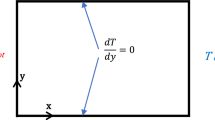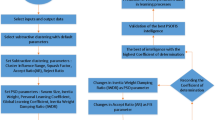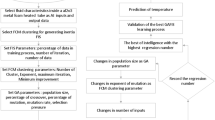Abstract
The CFD approach could waste a lot of time, effort, and cost for three-dimensional turbulent flow modeling. In the CFD method, any changes in the grid numbers in a specific region, the whole domain must be meshed and simulated again. More computational expenses are imposed when the mesh density must be increased. This study, for the first time, is aimed to develop a supplementary method using the artificial intelligence algorithm to reduce the post-processing calculations of the CFD approach. Eddy viscosity of alumina–water nanofluid turbulent flow inside a straight pipe is considered for prediction. The finite volume technique is used for solving the governing equations (i.e., mass, momentum, and energy) and the k–ɛ turbulence model of the CFD approach. Algorithms for artificial intelligence have shown promise for data learning and data patterning. In this study, the FVM solutions are learned by the artificial intelligence of the bee algorithm-based fuzzy inference system (BAFIS). The finite volume technique in the CFD modeling is integrated with the BAFIS to predict eddy viscosity in the nanofluid turbulent flow. Besides, the BAFIS performance and application are examined for meshing in the post-processing step of the CFD. In this way, the BAFIS learned the CFD-driven data for the existing nodes. Then the CFD data pattern is captured by the BAFIS. Finally, this CFD pattern is extended to more nodes. For achieving the intelligence, different input numbers (2 and 3), cluster numbers (5, 10, 15, and 20), as the fuzzy C-means clustering parameter, and neighborhood damping radius rates (0.85, 0.90, 0.95, and 0.99), as bee algorithm parameter, are investigated. The intelligence of the BAFIS was achieved for 3 inputs, the cluster number of 20, and the neighborhood damping radius rate of 0.99. The predictions of the eddy viscosity of BAFIS were the same as those of CFD. The BAFIS shows the ability for the accurate prediction of the eddy viscosity (regression number of 0.98). Comparing the time consumption of the methods, for the same number of nodes (i.e., 4,473) and the same computer specifications, the prediction time of the CFD (110 min) was around half of the learning time of BAFIS (52 min). It should be noted that after the data learning, the target variable, eddy viscosity in this study, could be predicted for any number of nodes (i.e., 774,771 nodes) within a negligible time (22 s). So, no significant time was consumed by BAFIS for the mesh increment. The BAFIS results covered the CFD results for additional nodes in the new dense mesh.













Similar content being viewed by others
Data availability
All data generated or analyzed during this study are included in this published article.
Abbreviations
- C p :
-
Heat capacity (J/kg K)
- d p :
-
Nanoparticle diameter (m)
- k:
-
Thermal conductivity (W/m K)
- k :
-
Turbulence kinetic energy (m2/s2)
- Re:
-
Reynolds number (\(\frac{\rho VD}{\mu }\))
- Pr:
-
Prandtl number (\(\frac{{\mu C}_{p}}{k}\))
- T :
-
Temperature (K)
- V :
-
Velocity (m/s)
- ε :
-
Dissipation rate of turbulence kinetic energy (m2/s3)
- µ :
-
Dynamic viscosity (kg/m s)
- µ t :
-
Eddy viscosity (kg/m s)
- ρ :
-
Density (kg/m3)
- ϕ :
-
Particle volume fraction
- BA:
-
Bee algorithm
- eff:
-
Effective
- FIS:
-
Fuzzy inference system
- f :
-
Fluid
- HTFs:
-
Heat transfer fluids
- P :
-
Percentage of trained data
- p :
-
Particle
- StD:
-
Standard deviation
- FCM:
-
Fuzzy C-means
- ML:
-
Machine learning
- NFs:
-
Nanofluids
References
Mehrali M et al (2014) Investigation of thermal conductivity and rheological properties of nanofluids containing graphene nanoplatelets. Nanoscale Res Lett 9(1):15
Mehrali M et al (2013) Preparation and properties of highly conductive palmitic acid/graphene oxide composites as thermal energy storage materials. Energy 58:628–634
Aghahadi MH, Niknejadiand M, Toghraie D (2019) An experimental study on the rheological behavior of hybrid Tungsten oxide (WO3)-MWCNTs/engine oil Newtonian nanofluids. J Mol Struct 1197:497–507
Zadeh AD, Toghraie D (2018) Experimental investigation for developing a new model for the dynamic viscosity of silver/ethylene glycol nanofluid at different temperatures and solid volume fractions. J Therm Anal Calorim 131(2):1449–1461
Khodadadi H, Toghraieand D, Karimipour A (2019) Effects of nanoparticles to present a statistical model for the viscosity of MgO-Water nanofluid. Powder Technol 342:166–180
Goodarzi M et al (2019) Experimental evaluation of dynamic viscosity of ZnO–MWCNTs/engine oil hybrid nanolubricant based on changes in temperature and concentration. J Therm Anal Calorim 136(2):513–525
Saeedi AH, Akbariand M, Toghraie D (2018) An experimental study on rheological behavior of a nanofluid containing oxide nanoparticle and proposing a new correlation. Phys E 99:285–293
Ruhani B, Barnoonand P, Toghraie D (2019) Statistical investigation for developing a new model for rheological behavior of Silica–ethylene glycol/Water hybrid Newtonian nanofluid using experimental data. Phys A 525:616–627
Ruhani B et al (2019) Statistical investigation for developing a new model for rheological behavior of ZnO–Ag (50%–50%)/Water hybrid Newtonian nanofluid using experimental data. Phys A 525:741–751
Behroyan I et al (2015) Turbulent forced convection of Cu–water nanofluid: CFD model comparison. Int Commun Heat Mass Transf 67:163–172
Behroyan I et al (2016) A comprehensive comparison of various CFD models for convective heat transfer of Al2O3 nanofluid inside a heated tube. Int Commun Heat Mass Transf 70:27–37
Ganesan P et al (2016) Turbulent forced convection of Cu–water nanofluid in a heated tube: improvement of the two-phase model. Numer Heat Transf Part A: Appl 69(4):401–420
Azizifar S, Ameriand M, Behroyan I (2020) Subcooled flow boiling of water in a metal-foam tube: an experimental study. Int Commun Heat Mass Transf 118:104897
Alawi OA et al (2014) Fluid flow and heat transfer characteristics of nanofluids in heat pipes: a review. Int Commun Heat Mass Transf 56:50–62
Moraveji A, Toghraie D (2017) Computational fluid dynamics simulation of heat transfer and fluid flow characteristics in a vortex tube by considering the various parameters. Int J Heat Mass Transf 113:432–443
Samadifar M, Toghraie D (2018) Numerical simulation of heat transfer enhancement in a plate-fin heat exchanger using a new type of vortex generators. Appl Therm Eng 133:671–681
Toghraie D (2016) Numerical thermal analysis of water’s boiling heat transfer based on a turbulent jet impingement on heated surface. Phys E 84:454–465
Babanezhad M et al (2020) Developing intelligent algorithm as a machine learning overview over the big data generated by euler-euler method to simulate bubble column reactor hydrodynamics. ACS Omega 5(32):20558–20566
Babanezhad M et al (2020) Functional input and membership characteristics in the accuracy of machine learning approach for estimation of multiphase flow. Sci Rep 10(1):17793
Babanezhad M et al (2019) Liquid-phase chemical reactors: Development of 3D hybrid model based on CFD-adaptive network-based fuzzy inference system. Can J Chem Eng 97(S1):1676–1684
Cao Y et al (2020) Prediction of fluid pattern in a shear flow on intelligent neural nodes using ANFIS and LBM. Neural Comput Appl 32(17):13313–13321
Tian E et al (2020) Simulation of a bubble-column reactor by three-dimensional CFD: multidimension- and function-adaptive network-based fuzzy inference system. Int J Fuzzy Syst 22(2):477–490
Rostami S et al (2021) Measurement of the thermal conductivity of MWCNT-CuO/water hybrid nanofluid using artificial neural networks (ANNs). J Therm Anal Calorim 143(2):1097–1105
Akhgar A et al (2019) Developing dissimilar artificial neural networks (ANNs) to prediction the thermal conductivity of MWCNT-TiO2/Water-ethylene glycol hybrid nanofluid. Powder Technol 355:602–610
He W et al (2020) Using of artificial neural networks (ANNs) to predict the thermal conductivity of zinc oxide–silver (50%–50%)/water hybrid Newtonian nanofluid. Int Commun Heat Mass Transf 116:104645
Babanezhad M et al (2020) Computational modeling of transport in porous media using an adaptive network-based fuzzy inference system. ACS Omega 5(48):30826–30835
Babanezhad M et al (2021) Performance and application analysis of ANFIS artificial intelligence for pressure prediction of nanofluid convective flow in a heated pipe. Sci Rep 11(1):1–18
Babanezhad M et al (2021) Investigation on performance of particle swarm optimization (PSO) algorithm based fuzzy inference system (PSOFIS) in a combination of CFD modeling for prediction of fluid flow. Sci Rep 11(1):1–14
Babanezhad M et al (2021) Velocity prediction of nanofluid in a heated porous pipe: DEFIS learning of CFD results. Sci Rep 11(1):1–11
Babanezhad M et al (2021) Thermal prediction of turbulent forced convection of nanofluid using computational fluid dynamics coupled genetic algorithm with fuzzy interface system. Sci Rep 11(1):1–12
Babanezhad M et al (2021) Prediction of gas velocity in two-phase flow using developed fuzzy logic system with differential evolution algorithm. Sci Rep 11(1):1–14
Varol Y et al (2007) Prediction of flow fields and temperature distributions due to natural convection in a triangular enclosure using adaptive-network-based fuzzy inference system (ANFIS) and artificial neural network (ANN). Int Commun Heat Mass Transf 34(7):887–896
Selimefendigil F, Öztop HF (2014) Estimation of the mixed convection heat transfer of a rotating cylinder in a vented cavity subjected to nanofluid by using generalized neural networks. Numer Heat Transf, Part A: Appl 65(2):165–185
Selimefendigil F, Öztop HF (2015) Numerical study and pod-based prediction of natural convection in a ferrofluids–filled triangular cavity with generalized neural networks. Numer Heat Transf, Part A: Appl 67(10):1136–1161
Schlichting H, Gersten K (2016) Boundary-layer theory, Springer
Karimipour A et al (2012) Simulation of fluid flow and heat transfer in the inclined enclosure. Int J Mech Aerosp Eng 6:86–91
Ajeel RK et al (2019) Turbulent convective heat transfer of silica oxide nanofluid through corrugated channels: an experimental and numerical study. Int J Heat Mass Transf 145:118806
Gürdal M et al (2022) Numerical investigation on turbulent flow and heat transfer characteristics of ferro-nanofluid flowing in dimpled tube under magnetic field effect. Appl Therm Eng 200:117655
Bianco V, Mancaand O, Nardini S (2011) Numerical investigation on nanofluids turbulent convection heat transfer inside a circular tube. Int J Therm Sci 50(3):341–349
Chon CH et al (2005) Empirical correlation finding the role of temperature and particle size for nanofluid (Al2O3) thermal conductivity enhancement. Appl Phys Lett 87(15):153107
Maiga SEB et al (2004) Heat transfer behaviours of nanofluids in a uniformly heated tube. Superlattices Microstruct 35(3–6):543–557
Bergman TL, et al (2017) Fundamentals of heat and mass transfer. Wiley, New York
Xuan Y, Li Q (2003) Investigation on convective heat transfer and flow features of nanofluids. J Heat transf 125(1):151–155
Pham D, et al (2005) The bees algorithm. Technical note, Manufacturing engineering centre, Cardiff University, UK
Takagi T, Sugeno M (1985) Fuzzy identification of systems and its applications to modeling and control. IEEE Trans Syst Man Cybern 1:116–132
Martinez MN, Bartholomew MJ (2017) What does it “mean”? A review of interpreting and calculating different types of means and standard deviations. Pharmaceutics 9(2):14
Babanezhad M et al (2020) Prediction of turbulence eddy dissipation of water flow in a heated metal foam tube. Sci Rep 10(1):1–12
Babanezhad M et al (2020) Functional input and membership characteristics in the accuracy of machine learning approach for estimation of multiphase flow. Sci Rep 10(1):1–15
Author information
Authors and Affiliations
Corresponding author
Ethics declarations
Conflict of interest
The authors declare no conflict of interest.
Additional information
Publisher's Note
Springer Nature remains neutral with regard to jurisdictional claims in published maps and institutional affiliations.
Rights and permissions
Springer Nature or its licensor (e.g. a society or other partner) holds exclusive rights to this article under a publishing agreement with the author(s) or other rightsholder(s); author self-archiving of the accepted manuscript version of this article is solely governed by the terms of such publishing agreement and applicable law.
About this article
Cite this article
Azma, A., Behroyan, I., Babanezhad, M. et al. Fuzzy-based bee algorithm for machine learning and pattern recognition of computational data of nanofluid heat transfer. Neural Comput & Applic 35, 20087–20101 (2023). https://doi.org/10.1007/s00521-023-08851-z
Received:
Accepted:
Published:
Issue Date:
DOI: https://doi.org/10.1007/s00521-023-08851-z




